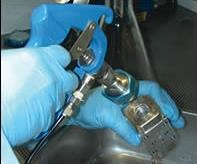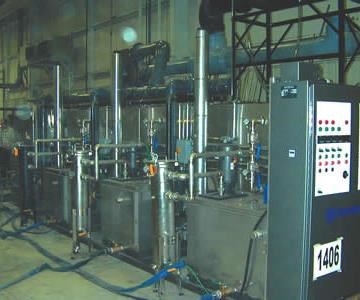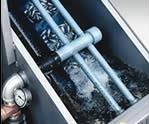Basic Aqueous Cleaning Processes And Selection Criteria
Parts cleaning, like most metalworking processes, is experiencing ever tightening specifications. Shops must continuously evaluate whether to clean parts in-house or use a supplier. This article looks at current aqueous cleaning processes and suggests criteria for the make or buy decision.
Maybe you’re a manufacturer who already cleans your own parts in-house, or maybe you’re looking to bring your parts cleaning in-house for any number of reasons including production control, leadtime reduction, quality control, and so on. Whatever your situation, one thing is for certain: As a manufacturer of parts, you are being pressured by the end user to provide a higher degree of part cleanliness. Cleanliness levels that were once acceptable may no longer suffice. Therefore, it’s becoming more and more critical to choose the best cleaning process for a particular operation.
The selection of the correct aqueous cleaning process should always start with a thorough understanding of the contamination that is on the parts as they are presented to the proposed cleaning system. The manufacturing engineer should have documented all the preceding processes the part has been exposed to, along with any other related manufacturing processes.
Featured Content
The basic building block elements that comprise any aqueous cleaning process will always consist of chemical, thermal and mechanical energies, along with dwell time. The old adage of the cleaning triangle with these three energies at the corners and time in the center simply states if one form of energy is increased, the other two forms of energy can typically be reduced. An example of this is the removal of aluminum oxide from a thermally deburred aluminum part. By increasing the part’s exposure to a high amount of mechanical energy—for example, ultrasonics, which greatly accelerates an acidic reaction—the acidic de-oxide solution concentration could be reduced along with the solution temperature. Finding the correct energy balance for the application is the answer to the cleaning equation.
When looking at a new aqueous cleaning process, it is important to have adequate, reliable lab work completed by more than one qualified vendor and the process proven. Most aqueous cleaning equipment manufacturers have an applications laboratory that can clean samples and help develop a cleaning process at no charge. An applications survey questionnaire should be completed and accompany the sample parts to the lab. This survey provides the lab technician with critical information that will help determine the best way to process the sample parts. Throughput requirements, critical surfaces, final part cleanliness, debit audit procedures and incoming part soil loading all affect how the sample parts should be processed and which type of equipment is best suited to fit the application. The more thoroughly a manufacturer can convey this survey information, the better for all parties.

To establish the cleaning needs for a specific application, most aqueous equipment suppliers have laboratories to establish a cleaning process for the job. Usually this service is at no charge.
Knowing what processes a part has undergone provides an invaluable insight for the cleaning equipment manufacturer’s sales engineer. Almost any cleaning application has been previously solved, and a knowledgable sales engineer probably has that history. The open issues such as material handling and floorspace constraints will remain the obvious capital costs. If the project is of any magnitude, most cleaning equipment manufacturers welcome potential customers to visit and witness first hand the second round of lab cleaning trials. It is also essential that the in-house sales engineer visit the customer’s facility and confirm all aspects of the proposed project prior to an order.
Close In these days of tighter capital equipment budgets, it is imperative that customers get the most efficient cleaning system for their money. However, purchasing the lowest capital cost system does not necessarily equate to the lowest total cost of ownership throughout the equipment’s lifetime. If a piece of equipment’s is going to be used on a regular basis, then the benefit of robust equipment with long-term reliability will probably outweigh initial capital savings. It’s like going to a large home improvement warehouse store and not buying the lowest priced item because in the end, it isn’t the right fit for the application. The same holds true for choosing an aqueous cleaning process and equipment.
Chemistry
When developing an aqueous cleaning process, the chemistry should typically be the first consideration. The part material and contamination will dictate what range of pH is tolerable for the application. Aqueous chemistry has a range from highly acidic with a pH of 1, to near neutral, to highly alkaline with a pH of 14. The goal is to use the least amount of chemistry at the lowest temperature with the least costly form of mechanical energy to achieve the necessary results in the required time cycle.
The basic rule remains to use alkaline chemistries to remove organic contaminations, such as oils, greases, coolants and animal fats, and to use acidic chemistries to remove inorganics, such as oxides. The neutral cleaners are excellent when used to accompany more mechanical energy systems such as ultrasonics. Reactive metals such as copper, brass and aluminum can tolerate only slightly alkaline or acidic chemistries before the material is attacked. Some chemistries have built-in inhibitors that limit the amount of aggressiveness the chemistry will have toward these types of metals. The softer, reactive metals are also prone to physical damage from the mechanical and thermal energies that are applied in the cleaning process. Tarnishing or discoloration from too high of a solution bath temperature will occur depending on the various alloys of these metals. Raising the solution temperature by 50°F will typically double the chemical reaction. Less reactive metals are candidates for stronger chemistries, higher solution temperature and increased mechanical energy. A steel part can withstand high temperatures and the aggressive alkaline detergent used to remove organic or inorganic soils, such as carbonized oils. The more a contaminant is inert, the more it warrants the use of mechanical energy to drive the chemistry underneath the contamination and allow the chemistry to break the molecular bond to the part substrate.
Knowing the true soil loading of the first wash stage will determine if additional capacity is required. High oil loads warrant, as a minimum, a two-stage wash process with the first stage (pre-wash) capable of removing the majority of the oils. In this application, the pre-wash stage should be equipped with an oil removal system to limit the redeposition of oil back on the parts before their transfer to the final wash stage. Oil removal systems range from simple belt, tube or wheel skimmers, to coalescing packages with polypro media, to the thin film airfoil-type separators. The system that is the right one for the application depends on many variables. In most organics removal applications, an oil removal package is beneficial because it extends chemistry life, reduces carry-over and lowers rinse water usage requirements.

High oil loads require a two-stage wash process, as a minimum, with the first stage (pre-wash) capable of removing most of the oils.
Thermal
Manufacturers narrowing their decision on the type of aqueous cleaning process that will best fit their applications should pay attention to the type, quality and capacity of the heating elements that are being offered. Only in the smallest of tanks should bolt-on strip heaters be considered. These have inherent limitations with regards to service life and heating capacity. The resistive heat load is the main energy user with most aqueous cleaning systems, and having these heaters properly sized and controlled has an effect on electrical usage costs. Immersion heaters, either over-the-side or screw-plug-type, should be selected for the proper watts per square inch of their surface area for the application. Chemistry breaks down and heater life is reduced if these parameters are not followed. Digital temperature controllers with thermocouples should be strongly considered more so than dial thermostats because of their visual monitoring of solution temperature and control of the dead band, which can extend both heater and contactor life. When process or solution storage tanks exceed 400 gallons, steam or gas heating should be strongly considered. Higher energy usage systems, such as large in-line spray washers, are good candidates for non-electric heating.

For large-capacity systems, when process or solution storage tanks exceed 400 gallons, steam or gas heating should seriously be considered.
Mechanical
The final and key piece to the aqueous cleaning process puzzle is the hardware. One of the lower cost alternatives for a batch wash application is the vertical agitators. Vertical agitators are used widely in pre-wash or cellular applications because of their forgiveness to be less affected by heavy oil loading. These tanks typically use a pneumatic cylinder with a work platform that forces the heated process fluid to flow in and around the parts as they are oscillated underneath the solution. The mechanics of lifting parts in and out of the solution allows the solution to quickly dispel contaminants. The addition of a motor-driven propeller to roll the solution while the parts are vertically agitating creates additional solution movement and pressures to further flush away soils. Spray under immersion is another form of turbulence that uses a recirculation pump and filter that discharges back into the tank through agitators to create increased directed solution movement. The addition of basket rotation to this system brings another level of mechanical impingement to the parts.
The next family of cost-effective cleaning systems is spray washers. A batch, rotating turntable-style cabinet washer can be tolerant to high soil loads and is used in both cellular and pre-wash applications. Conveyor-style spray washers also apply a high degree of mechanical impingement to parts, with the added benefits of increased production capacity and drying capability. Conveyor types range anywhere from overhead monorails to flat wire mesh to special rod fixture designs. Multiple stages of washing, rinsing, rust inhibiting and drying are common in conveyor washers. Positioning of the spray nozzles close to the work and pressures as much as 200 psi or more can produce consistent results.

Conveyor-style spray washers apply a high degree of mechanical impingement to parts with the added benefits of increased production capacity and drying capability.
Ultrasonics represents yet another family of cleaning systems. The use of ultrasonics has the potential to deliver the highest degree of mechanical energy to the cleaning process. This can allow the process to run with a lower thermal level and less aggressive chemistry. If parts cannot reach the level of cleanliness with the more conventional washing methods, then the use of ultrasonics should be explored.
Selecting a qualified equipment supplier who adheres to the basic cleaning building blocks of chemical, thermal and mechanical energies as well as time, will help ensure the best cleaning process for the operation.
— Stoelting Cleaning Equipment
RELATED CONTENT
-
Get to Know Cleanliness Standards
With a small amount of practice, it is possible to understand the underlying motivation of a cleaning standard and to figure out the specific aspects of the specification that are applicable to the customer.
-
Selecting Solvents for Precision Cleaning
Stringent standards on precision cleaning ensure reliable and trouble-free performance in the final product.
-
VIDEO: Vapor Degreasing Process Uses TCE Replacement to Eliminate Hazardous Waste
A solid relationship with a solvent manufacturer has aided Electro-Spec Inc. with the implementation of a trichloroethylene replacement material in its vacuum degreasing unit to clean a customer’s micromachined parts more efficiently.





